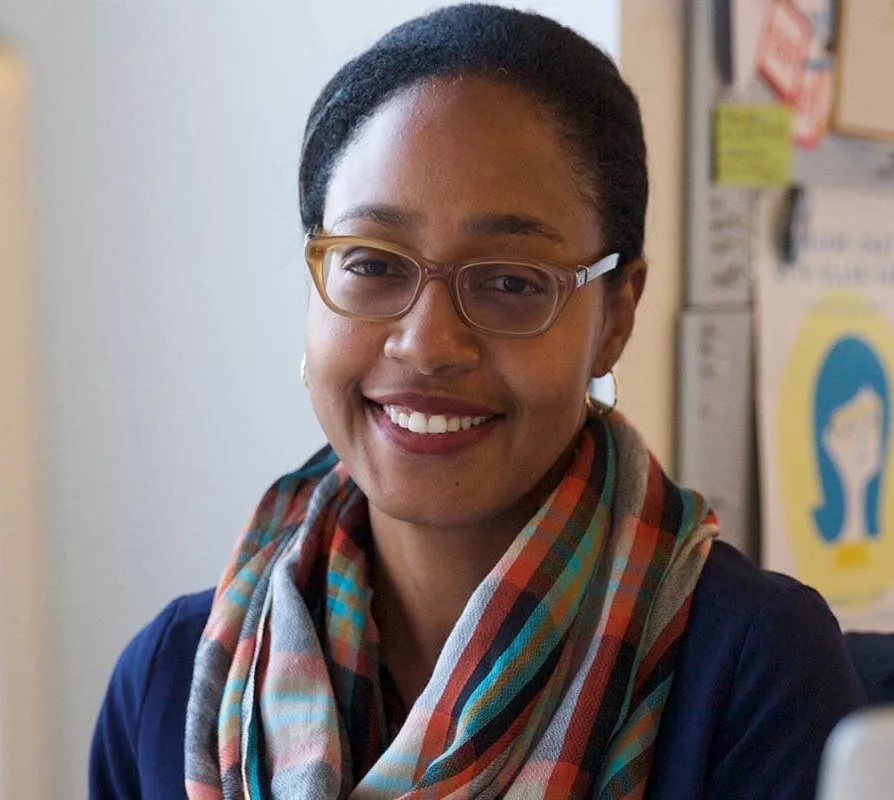San Francisco software startup Asana has invested heavily in designing an authentic, mindful, high-performing culture. (See also: Our detailed look inside the company; an interview with CEO Dustin Moskovitz.) And a big part of that authenticity is making sure every employee can thrive as themselves, and that all selves feel welcome.
Meanwhile, diversity and inclusion are hot topics within the tech world, where women and people of color are still hugely underrepresented, especially in technical roles. As Asana itself said in announcing its recent diversity report, “It’s probably getting tiresome to hear from yet another tech company that ‘we’ve got work to do,’ but this statement accurately reflects the reality of where we are today.”
Yet Asana is doing that work. In 2015 — before the company reached 200 full-time staff — its leaders hired Sonja Gittens-Ottley to focus on diversity and inclusion programs, goals, and measurements full time. Before joining the Asana team, Gittens-Ottley held similar roles at Facebook and Yahoo.
We recently sat down with her at the Asana offices to hear her take on what diversity means, what success looks like, and what she wishes all companies were doing.
Why don’t you start by telling us what you do? How you understand your role?
Sonja Gittens-Ottley: As you’re building a company, you’re thinking about: Who’s going to run my compensation program? Where am I going to find customers? Where’s the next market I should be going to? In the same way, one of the things you should be thinking is: Who’s coming into this company? How am I building a base of employees that reflects the kind of company I want us to be in the future? Part of that is building a company that’s diverse. “Diverse” meaning it has the sort of representation you want to see based on your community, your country, your markets.
It should be a business goal like any other business goal. And that’s the approach that we’ve taken here. We have a clear annual objective on where we want to be in terms of diversity and inclusion. We’ve looked at it as three pillars of a strategy: “Build” is creating a culture that is inclusive. “Recruit” is who am I recruiting, how am I recruiting them? “Thrive” is I’ve recruited all of these people, how are we getting them to stay? How are we making sure we’re meeting their needs so that they can be their full selves in the office?
Underneath all of that, like every other business objective, is “What’s the data I’m looking at?” In terms of recruiting, it could be what’s our applicant data? For that inclusion piece, it’s: what’s the engagement of my majority groups compared to my non-majority groups? What’s my attrition like? What are promotions like? You have to start looking at trends.
“Thrive” is also about creating a safe space to have conversations that are very uncomfortable in work settings. You have often been told that you should not be talking about X in the office. You’re just there to do your job. Well, maybe not. Maybe you want to have those discussions, because things are on your mind and stopping you from doing your work because you’re thinking about them. You should absolutely feel comfortable having those discussions in the office. Or at least know there is a place for you to have them if you want to.
Does a story come to mind of a real win during your time here?
SG: I’d been here for about three months; the company was less than 200 people at that point. I wanted to have a discussion around being Black in America. I was clear to frame it as, “We’re going to talk about something that is often uncomfortable to talk about. We don’t have a lot of Black people in this office. We’re going to have a conversation about what it’s like, and the people who are going to talk about it are not speaking for all Black people, they are sharing their experiences as Black people.”
My panelists were ready to handle any sort of question. Two things happened. One, attendance was 90 percent plus, which was great. I think maybe seven or eight people did not attend. Two, people asked some simple questions like, “How can I protest?” “How can I support?” Questions that might appear mundane, but started to set a scene for “this is a safe space to ask and receive questions.” It showed that this is real. This is what we’re going to be doing. We’re going to be talking about these things.
It also set the tone for starting to have discussions around what it means to be an ally. What it means when you do not have to think about these things and you willingly decide to take on these things. What’s the role you can play in this? Changing it from words to action. Here’s the steps you can take, here’s the things that you should be doing.
We’ve continued the Real Talk series with other events where we talk about many different things, from how to be an ally to being Muslim in America. That, to me, I think is still one of my happiest days just in terms of getting people comfortable to have those kinds of conversations.
Why did it work here so successfully? What was the groundwork that needed to be in place?
SG: Guidelines ahead of time. “Here’s what we’re going to be talking about, here are some resources that you can look at before we even get into the room” — a couple of short TED talks, some articles. And being really clear that all are welcome. It’s something I make sure I include in any event I’m doing. I want people to understand that my default is that we want you in this room. Even if you don’t identify as a member of the community, we want you in this room, whatever we’re talking about.
What common mistakes do you see at companies that want to start putting energy and attention towards this issue?
SG: One is not starting it early. One is depending too much on employees’ passion for it. And by that I mean that at a number of companies, it’s an employee seeing that, “This isn’t right, how can I help?” and trying to do that in addition to their day job. That’s useful but it also has to be supported. It absolutely cannot work if the leadership has not bought into this and sees it as an imperative.
You said “not starting it early.” How soon is too soon; what can you do when you’re a really small company?
SG: Think about: What are the perspectives that we might be missing? Would it help our business, for example, if we thought about actively searching for people who are from a different race? What about people who are older? What about men? Start to think about what might we be missing, what perspectives are we not hearing at the table, how can we find those people. It’s easier when you are not searching for people because you can step back and think.
So if you say for example, “It might be great if we get somebody who’s older, who has more experience. Let’s start looking at X. Let’s start searching for people who have done this in their career.” It might translate into different things. It might translate into where we’re searching for people. What are the events we’re going to where these people might exist? We start to make connections and build relationships so that when we actually are ready to hire, we’ve already built those connections, as opposed to, “We now need to hire. We’re at twelve people and we have nobody who’s older than X. We now need to find somebody who’s older.” The search becomes a little more frantic.
So the big takeaway there is building relationships, having partners out there. It’s something that has been useful for us. You can just partner with organizations who are already in the community, that are connecting with people who you also want to be connected with.
What do you think Asana does particularly well around this issue of diversity, and also what’s the big growth area right now?
SG: Having mindfulness at the core of what we do. Being intentional seems natural for us, and that translates into, “This is why we’re doing this. This is how we’re going to do it. This is how we’re going to portray it.”
Also being comfortable talking about where we’re not succeeding. One of the processes that we have here is a 5 Whys process. We can have a conversation about something that went wrong without casting blame. We haven’t done it as much for diversity and inclusion efforts but we know that we could. It creates a sense of space to try and feel in a way that I haven’t seen necessarily occur at other places.
The other thing that works for us is Roadmap Week. It’s very useful because I get to sit in a room with stakeholders, both people I’ve picked and people who have self-selected to come into my discussions, and have a clear conversation around, “This is what I’m thinking. These are my thoughts. These are the risks that I see. This is the vision I have for it. This is what it’ll look like if it fails.” Getting buy-in, getting conversation, I’m getting hard questions and I’m using that to set the scene for what we’re going to do for the next six months.
That provides a lot of clarity around approach, structure, and also allows me to have that conversation around, “I can’t believe you all are fighting me on this,” but understanding where it’s coming from because we’ve had this discussion. We’re clear on what we’re trying to achieve and we’re doing it together. Then I can go run with my program. This is still my program to own, but I’ve built that collaboration so that people have a sense of where this is all headed and understanding where that rolls into company objectives.
Are there any other moments that you’ve experienced here where you’re just like, “Yes. I’m so glad that happened,” even if it was a failure that you learned from?
SG: When I’ve heard people say things I’ve said. That gives me hope.
Like what?
SG: Like I always tell people that if there’s one thing that you’ll leave with it’s that you’ve said “Black” in the same tone that you’ve said the rest of your sentence. As in, “I have met five Black people,” as opposed to, “I have met five Black people.” I always feel happy when I hear people say, “If there’s one thing that you leave with, is that your tone does not change when you talk about race.” That is something that always makes me happy because I think part of it is getting people comfortable with what is often uncomfortable.
The other thing that always makes me happy is when we have discussions around diversity and inclusion and people who are overrepresented are in the room. “You don’t have to be here but you understand that you need to be here because you understand you have a role to play.” This is not the job of people who are underrepresented. This is everyone’s job. And the more that people understand that, the easier this will get because that’s the only way things are going to change.
What do you wish more people in business understood or would start doing?
SG: I wish people understood that diversity and inclusion is not a charity job. You’re not trying to help somebody, specifically around recruiting. You’re trying to find the best people for roles and we have typically overlooked the best people for roles because they have not had access. There are a lot of great people out there. We as companies are not doing all we could to find them.
I also wish that people understood that this is bigger than trying to solve it by yourself; there is room for companies to work together on this. I feel as though my peers, people with my job in other companies, we’re starting to understand that, and we are always talking about what we can do and best practices.
What’s giving you hope?
SG: The way the conversation has changed around diversity and inclusion in tech. Maybe three years ago it was around, “What’s your numbers? What does your company look like?” Conversation has changed into, “How are people thriving?” So it’s become more and more inclusive. It’s gone from pure stats to inclusive/belonging. How are we creating that space of understanding? That gives me hope that we will all end up in a place where whatever my identity is, it’s recognized.
I don’t care for being color blind or whatever blind because I feel as though that negates the person’s experience — what they bring in. Having understanding allows you to recognize whatever someone brings to the table. Whatever that is, race, ethnicity, socioeconomic background, religion, sexual orientation, everything. All 500 million things they bring to the table. That gives me hope.





